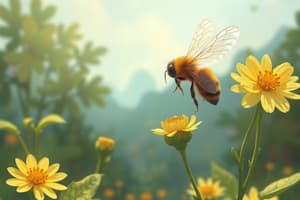Podcast
Questions and Answers
What is a characteristic of asexual reproduction?
What is a characteristic of asexual reproduction?
- Produces offspring with different genetic makeup
- Produces offspring from a single parent (correct)
- Involves two parents
- Involves gametes
What ensures the continuity and survival of a species?
What ensures the continuity and survival of a species?
- Random mutation
- Cooperation between different species
- The process of reproduction (correct)
- Variation in offspring
Which of the following is a method of asexual reproduction?
Which of the following is a method of asexual reproduction?
- Fertilization
- Cross-pollination
- Self-pollination
- Tissue culture (correct)
Which part of a flower is primarily involved in fertilization?
Which part of a flower is primarily involved in fertilization?
What type of pollination occurs when pollen from one flower fertilizes the ovule of another flower?
What type of pollination occurs when pollen from one flower fertilizes the ovule of another flower?
Which of the following is NOT an agent of pollination?
Which of the following is NOT an agent of pollination?
Flashcards are hidden until you start studying
Study Notes
Types of Reproduction
- Reproduction is essential for the continuity and survival of species.
- Two primary modes of reproduction exist: asexual and sexual.
Asexual Reproduction
- Asexual reproduction involves a single parent organism.
- Offspring produced are genetically identical to the parent.
- This mode excludes the involvement of gametes, ensuring a quick and efficient means of propagation.
Types of Asexual Reproduction
- Various methods exist for asexual reproduction, including:
- Vegetative propagation: Growth of new plants from parts of the parent plant (e.g., stems, roots, leaves).
- Artificial propagation: Human-assisted methods to propagate plants.
Methods of Vegetative Propagation
- Techniques include cuttings, layering, and grafting.
- Grafting combines parts from two different plants to produce desired traits.
Methods of Artificial Propagation
- Involves techniques such as:
- Tissue culture: Cultivating plant cells in a controlled environment to produce new plants.
- Enables mass production and preservation of certain plant species.
Sexual Reproduction in Plants
- Involves the fusion of male and female gametes resulting in genetic diversity.
- Structure of a typical flower includes parts: petals, sepals, stamens (male), and carpels (female).
Pollination
- Crucial for sexual reproduction, involves transferring pollen from male structures to female structures.
- Two types of pollination:
- Self-pollination: Pollen fertilizes ovules of the same flower.
- Cross-pollination: Pollen from one flower fertilizes ovules of another flower.
Agents of Pollination
- Common pollinators include wind, water, insects, and animals.
- Each agent plays a unique role in enhancing genetic diversity among plants.
Artificial Pollination
- Humans manually facilitate the pollination process for crop production or to ensure specific breeding results.
Fertilization
- The process that occurs post-pollination, leading to the formation of seeds and fruit, marking the transition from pollination to the production of the next generation of plants.
Studying That Suits You
Use AI to generate personalized quizzes and flashcards to suit your learning preferences.




